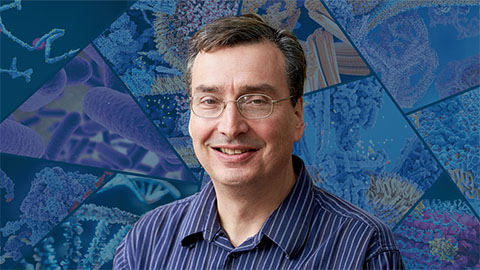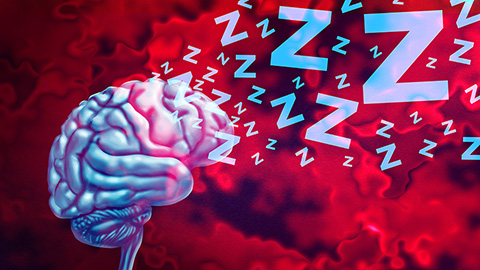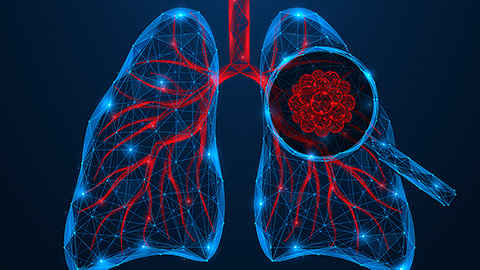National Influenza Vaccination Week
The year may be winding down, but flu season is still heating up. If you’ve been slacking on getting your annual shot, it’s not too late — in fact, the Centers for Disease Control and Prevention designated the first week of December as National Influenza Vaccination Week. While the flu vaccine remains the best line of defense against the fever, fatigue and range of respiratory symptoms of a genuine influenza infection, ASBMB members have been investigating how influenza viruses interact with our cells and uncovering leads for new antivirals and improved vaccines.
Why glycosylation matters in building a better flu vaccine
If influenza viruses were DNA-based, we may well have developed a universal vaccine decades ago. But, as retroviruses, they have a tendency to rack up errors every time they replicate, gradually changing the makeup of their hemagglutinin and neuraminidase proteins and slipping ever beyond the protective yoke of each season’s vaccine. While efforts to develop a universal flu vaccine are under way at labs around the world, flu vaccine design processes currently don’t account for the glycosylation that influenza A viruses, the primary cause of human influenza illnesses, use to evade host antibodies. Deborah Chang and Joseph Zaia at Boston University recently made the case in the journal Molecular & Cellular Proteomics that developing methods to determine site-specific glycosylation of glycoproteins in influenza A viruses could enhance the efficacy of future flu vaccines.
Forever in search of new antivirals
Developing new antivirals can feel like an exercise in futility — just over a year after the drug Xofluza was approved for distribution in the United States, scientists at the University of Wisconsin–Madison found that influenza viruses in a quarter of patients who took the drug developed resistance to it. While few drugs make it all the way through the development pipeline, biochemists are regularly discovering compounds that can take advantage of novel mechanisms to inhibit viral replication.
Histone deacetylases play a role in preventing influenza replication
Like almost all viruses, influenza A viruses hijack host machinery to replicate. In response to evidence that an optimal acetylation environment in host cells is favorable to this process, researchers at the University of Otago in New Zealand investigated the effects of histone deacetylases, which negatively regulate acetylation, against IAVs.
Influenza viruses love lipids
After influenza has hijacked a host cell’s machinery to crank out its RNA and proteins, it needs to get them wrapped in a protective lipid envelope so that new virions can venture forth and infect more host cells. Researchers at the University of Singapore recently used a mass spectrometry-based lipidomics approach to investigate how IAVs interact with the host cells’ lipid metabolism during different stages of infection. They found that function of membrane-bound peroxisomes to be a common metabolic denominator and a potential key determinant for influenza virus replication.
Gut microbes, glycosphingolipids and influenza
Invariant natural killer T cells are versatile — they thwart tumors, attack pathogenic bacteria viruses and play a role in autoimmune diseases — and the glycosphingolipid α-galactosylceramide, produced by Bacteroides in the human gut, is key to their activation. Researchers at the University of Marburg and German Cancer Research Center recently found that conditions including colitis, consumption of a Western diet and infection by influenza A virus tend to decrease levels of αGalCer. This suggests that modulating gut microbial-derived immunogenic lipids including αGalCerML may impact immunity.
Hosts and their viruses: a thematic series of review articles
Hot off the heels of the swine flu epidemic — an H5N1 strain from the antigenic shift that happened when two starkly different influenza strains infected the same pig population — Charles Samuel helped organize a JBC minireview series with the aim of understanding the structural basis for interactions between influenza viruses and host cells. Read the series.
Enjoy reading ASBMB Today?
Become a member to receive the print edition four times a year and the digital edition monthly.
Learn moreGet the latest from ASBMB Today
Enter your email address, and we’ll send you a weekly email with recent articles, interviews and more.
Latest in Science
Science highlights or most popular articles

Unraveling the language of histones
Philip Cole presented his research on how posttranslational modifications to histones are involved in gene expression and how these modifications could be therapeutically targeted to treat diseases like cancer.

How Alixorexton could transform narcolepsy treatment
A new investigational drug, alixorexton, targets the brain’s orexin system to restore wakefulness in people with narcolepsy type 1. Alkermes chemist Brian Raymer shares how molecular modeling turned a lab idea into a promising phase 3 therapy.

Phosphatases and pupils: A dual legacy
Yale professor Anton Bennett explores how protein tyrosine phosphatases shape disease, while building a legacy of mentorship that expands opportunity and fuels discovery in biochemistry and molecular biology.

Extracellular vesicles offer clues to cattle reproduction
Extracellular vesicles from pregnant cattle support embryo development better than laboratory models, highlighting their potential to improve reproductive efficiency in bovine embryo cultures. Read more about this recent MCP paper.

Proteomics reveals protein shifts in diabetic eye disease
Using proteomics, researchers identified protein changes in eye fluid that mark diabetic retinopathy progression and may serve as biomarkers for vision-threatening complications. Read more about this recent MCP paper.

Protein modifications drive lung cancer resistance
New assay enriches protein modifications in a single process, enabling detection of key changes in drug-resistant lung cancer cells that may guide future therapies.

